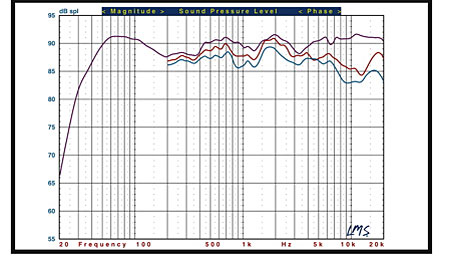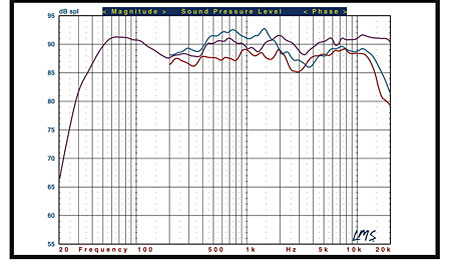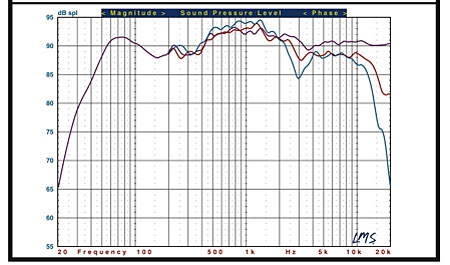Monitor Audio Platinum Surround Speaker System Measurements
The measurements shown were taken with the grilles removed. The on-axis response changes with the grilles in place (not shown) were relatively benign.
The impedances given here were derived from the measured impedance curves (not shown).
All figures: Violet curve: pseudo-anechoic response on the tweeter axis, averaged across a 30° horizontal window, combined with nearfield responses of the woofers and ports. All measurements were taken at one meter.
PL300
Minimum impedance: 6.1Ω at 97Hz
Nominal impedance: 8Ω
Cabinet tuning: 31Hz
Effective bass extension (-10dB): 29Hz (relative to the level at 100Hz)
Sensitivity: 90dB/2.83V/m
Our impedance measurement showed a minimum value well above the manufacturer's specified nominal value of 4Ω. The PL300 should be an easy load to drive, though the manufacturer recommends a hefty amplifier to get the best from the speaker (the Parasound Halo A51 amp used in the review is rated at 250 watts per channel into 8Ω).

Fig.1: PL300, pseudo-anechoic response, off-center in the horizontal plane, at 45° (red) and 60° (blue).
The measured response of the PL300 is relatively smooth, both on and off axis horizontally. The high-frequency response remains strong without significant peaks up to the 20kHz limit of our measurements.
A slight rise centered around 700Hz might account for the forwardness noted in the review, and another rise around 2kHz could suggest the occasional glare I also noted. Both measured deviations, however, are quite small.
The bass is clearly powerful and deeply extended; a relatively large room might be the best fit for the PL300.

Fig.2: PL300, pseudo-anechoic response at 15° above (red) and 15° below (blue) the tweeter axis.
The best response is found as close to the tweeter axis as possible. Note that the response forms a moderately elevated plateau centered around 1kHz when the seated ear height is below the tweeter axis.
PLC350
Minimum impedance: 6.2Ω at 100Hz
Nominal impedance: 8Ω
Cabinet tuning: 32Hz
Effective bass extension (-10dB): 33Hz (relative to the level at 100Hz)
Sensitivity: 91dB/2.83V/m
As with the PL300, the PLC350's measured impedance is higher than the manufacturer's specs, which should also make it relatively easy to drive. Interestingly, the impedances are almost identical for both speakers, suggesting not only identical drivers (which is visually apparent) but a similar crossover network as well. The PLC350's measured bass response is also nearly as extended as the PL300's.

Fig.3a: PLC350, pseudo-anechoic response in the horizontal plane, at 45° (red) and 60° (blue).
The PLC350's averaged frontal response is fairly uniform, though marred a bit by a broad rise that extends from roughly 500Hz to 2.5kHz peaking at a maximum of about +3dB. This is the region covered by the midrange driver, suggesting that the driver is balanced a bit too high. This would explain why I found the center to be slightly forward-sounding when auditioned on axis. Above 2.5kHz, the averaged on-axis response is superb.
Off axis, we see some problems. The response holds up reasonably well up to modest off-axis angles, even tapering off that presence-region rise a bit, as heard in the listening tests. But suckouts begin to show up in the midrange as you approach 30 degrees off center and beyond. While the speaker's off-axis response holds up well in the low-treble region (where the responses of the vertically oriented midrange and tweeter overlap), lower down it shows the same type of irregularities found in two-way center speakers that use horizontally configured drivers. The speaker will sound best if you don't move further to the left or right than the outside seats on a typical sofa.

Fig.4: PLC350, pseudo-anechoic response at 15° above (red) and 15° below (blue) the tweeter axis.
The PLC350's vertical response curves indicate that any reasonable seating position relative to tweeter height will be satisfactory, though as with the PL300, it's better to be slightly above the tweeter than below.





























































